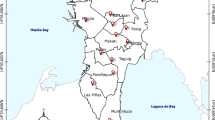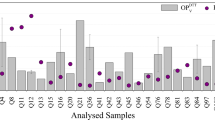Abstract
Particulate matters were collected at different urban and suburban locations in greater Dhaka region with a low volume sampler on Quartz filter papers. Total carbon (TC) was determined with combustion method and elemental carbon (EC) with two steps thermal method. Organic carbon (OC) was calculated from the difference between TC and EC. The grand average TC, EC, and OC concentrations in greater Dhaka were 81.2, 25.4, and 55.4 μg m−3, respectively. Average EC concentration was 32.4 ± 17.1 μg m−3 (urban Dhaka) and 18.4 ± 7.9 μg m−3 (suburban Dhaka). Average OC concentration was 76.7 ± 58.0 μg m−3 (urban Dhaka) and 34.1 ± 21.7 μg m−3 (suburban Dhaka). The average TC, OC, and EC concentrations at urban Dhaka were 52.2%, 55.5%, and 43.2% higher than the suburban Dhaka values, respectively. Very high concentrations were observed for carbonaceous species in Dhaka region. These may be due to the increased number of traffic vehicles, traffic jams, and also contributions from industrial growth in Dhaka city. Average EC/TC ratios are 0.34 for urban Dhaka and 0.37 for suburban Dhaka indicating typical fossil fuel is the source of carbonaceous species in greater Dhaka. The OC/EC ratio at urban Dhaka is 2.17, which is an indication of secondary OC formation rather than primary. The suburban Dhaka OC/EC ratio is 1.86 indicating OC is mostly primary origin. OC was the major carbonaceous component representing about 68% of the TC content (65% for suburban Dhaka and 70% urban Dhaka). A high fraction of OC in Dhaka aerosol may have serious implications for human health and climate change.


Similar content being viewed by others
References
Adler KB, Fischer BM (1994) Interactions between respiratory epithelial cells and cytokines: relationships to lung inflammation. Annals of the NY Acad Sci 725:128–145
Arbex MA, Martins LC, de Oliveira RC, Pereira LAM, Arbex FF et al (2007) Air pollution from biomass burning and asthma hospital admissions in a sugar cane plantation area in Brazil. J Epidemiol Community Health 61:395–400
Begum BA, Kim E, Biswas SK, Hopke PK (2004) Investigation of sources of atmospheric aerosol at urban and semi-urban areas in Bangladesh. Atmos Environ 38:3025–3038. doi:10.1016/j.atmosenv.2004.02.042
Cachier H, Bremond M-P, Patrick B-M (1989) Determination of atmospheric soot carbon with a simple thermal method. Tellus 41B:379–390
Cao JJ, Lee SC, Ho KF, Zhang XY, Zou SC, Fung KK, Chow JC, Watson JG (2003) Characteristics of carbonaceous aerosol in Pearl River Delta region, China during 2001 winter period. Atmos Environ 37(11):1451–1460
Cao JJ, Wu F, Chow JC, Lee SC, Li Y, Chen SW, An ZS, Fung KK, Watson JG, Zhu CS, Liu SX (2005) Characterization and source apportionment of atmospheric organic and elemental carbon during fall and winter of 2003 in Xi’an, China. Atmos Chem Phys 5:3127–3137
Chow JC, Watson JG, Fujuta EM, Lu Z, Lawson DR (1994) Temporal and spatial variations of PM2.5 and PM10 aerosol in the southern California air quality study. Atmos Environ 28:2061–2080
Chow JC, Watson JG, Lu Z, Lowentha DH, Frazier CA, Solomon PA, Thuillier RH, Magliano KL (1996) Descriptive analysis of PM2.5 and PM10 at regionally representative locations during SJVAQS/AUSPEX. Atmos Environ 30(12):2079–2112
Haywood JM, Ramaswamy V (1998) Global sensitivity studies of the direct radiative forcing due to anthropogenic sulfate and black carbon aerosol. J Geophys Res 103:6043–6058
Hileman B (1981) Particulate matter: the inevitable variety. Environ Sci Technol 15:983–986
Kendall M, Duarte A, Rocha-Santos T, Hamilton R, Williams I (2002) Airborne particulate-associated polyaromatic hydrocarbons, n-alkanes, elemental and organic carbon in three European cities. J Environ Monit 4:890–896
Kim YP, Moon K-C, Lee JH, Baik NJ (1999) Concentrations of carbonaceous species in particles at Seoul and Cheju in Korea. Atmos Environ 33:2751–2758
Lin JJ, Tai H-S (2001) Concentrations and distributions of carbonaceous species in ambient particles in Kaohsiung City, Taiwan. Atmos Environ 35:2627–2636
Novakov T, Penner JE (1993) Large contribution of organic aerosols to cloud condensation-nuclei concentrations. Nature 365:823–826
Park SS, Kim YJ, Fung K (2002) PM2.5 carbon measurements in two urban areas: Seoul and Kwangju, Korea. Atmos Environ 36:1287–1297
Pitts JN Jr (1983) Formation and fate of gaseous and particulate mutagens and carcinogens in real and simulated atmospheres. Environ Health Perspect 47:115–140
Puxbaum H, Rendl J (1983) Ein automatisches Analysatorsystemzur Bestimmung von Kholenstoff und Schwefel in Luftgetragenen Stäuben. Microchimica Acta I: 263–272
Robert HO, Tohno S, Kasahara M, Hitzenberger R (2002) Long-term characterization of carbonaceous aerosol in Uji, Japan. Atmos Environ 36:1267–1275
Salam A, Bauer H, Kassin K, Ullah SM, Puxbaum H (2003a) Aerosol chemical characteristics of a mega-city in Southeast Asia (Dhaka, Bangladesh). Atmos Environ 37:2517–2528. doi:10.1016/S1352-2310(03),00135-3
Salam A, Bauer H, Kassin K, Ullah SM, Puxbaum H (2003b) Aerosol chemical characteristics of an island site in the Bay of Bengal (Bhola, Bangladesh). J Environ Monit 5(3):483–490
Sarkar MAR, Islam SMN (1998) Rural energy and its utilization in Bangladesh. Energy 23(9):785–789
Schmid H, Laskus Abraham HJ, Baltensperger U, Lavanchy V, Bjzjak M, Burba P, Cachier H, Crow D, Chow J, Gnauk T, Even A, ten Brink HM, Giesen KP, Hitzenberger R, Hueglin C, Maenhaut W, Pio C, Carvalho A, Putaud JP, Sauntry DT, Puxbaum H (2001) Results of the “carbon conference” international aerosol carbon round robin test stage 1. Atmos Environ 35:2111–2121
Schuetzle D (1983) Sampling of vehicle emissions for chemical analysis and biological testing. Environ Health Perspect 47:65–80
Smith DJT, Harrision RM, Luhana L, Casimiro AP, Castro LM, Tariq MN, Hayat S, Quraishi T (1996) Concentrations of particulate airborne polycyclic aromatic hydrocarbons and metals collected in Lahore, Pakistan. Atmos Environ 30:4031–4040
Turpin BJ, Huntzicker JJ (1995) Identification of secondary organic episodes and quantification of primary and secondary organic aerosol concentrations during SCAQS. Atmos Environ 29:3527–3544
Turpin BJ, Huntzicker JJ, Larson SM, Cass GR (1991) Los Angeles summer midday particulate carbon: primary and secondary aerosol. Environ Sci Tech 25:1788–1793
Tzimou-Tsitouridou R (2004) Carbonaceous species of TSP in urban and rural sites around coal-fired power stations in Northwestern Greece. Talanta 62:115–122
Venkataraman C, Reddy CK, Josson S, Reddy MS (2002) Aerosol size and chemical characteristics at Mumbai, India, during the INDOEX-IFP (1999). Atmos Environ 36:1979–1991
Yu JZ, Tung JWT, Wu AWM, Lau AKH, Louie PK-K, Fung JCH (2004) Abundance and seasonal characteristics of elemental and organic carbon in Hong Kong PM10. Atmos Environ 38:1511–1521
Zeng T, Wang Y (2011) Nationwide summer peaks of OC/EC ratios in the contiguous United States. Atmos Environ 45:578–586
Acknowledgments
We thank Prof. Hans Puxbaum’s group, Technical University of Vienna, Austria for the instrumental support for particulate matter sampling and also in the analyses of the filter samples for carbonaceous species.
Author information
Authors and Affiliations
Corresponding author
Rights and permissions
About this article
Cite this article
Salam, A., Ullah, M.B., Islam, M.S. et al. Carbonaceous species in total suspended particulate matters at different urban and suburban locations in the Greater Dhaka region, Bangladesh. Air Qual Atmos Health 6, 239–245 (2013). https://doi.org/10.1007/s11869-011-0166-z
Received:
Accepted:
Published:
Issue Date:
DOI: https://doi.org/10.1007/s11869-011-0166-z




